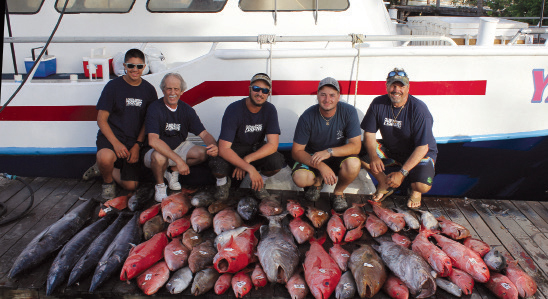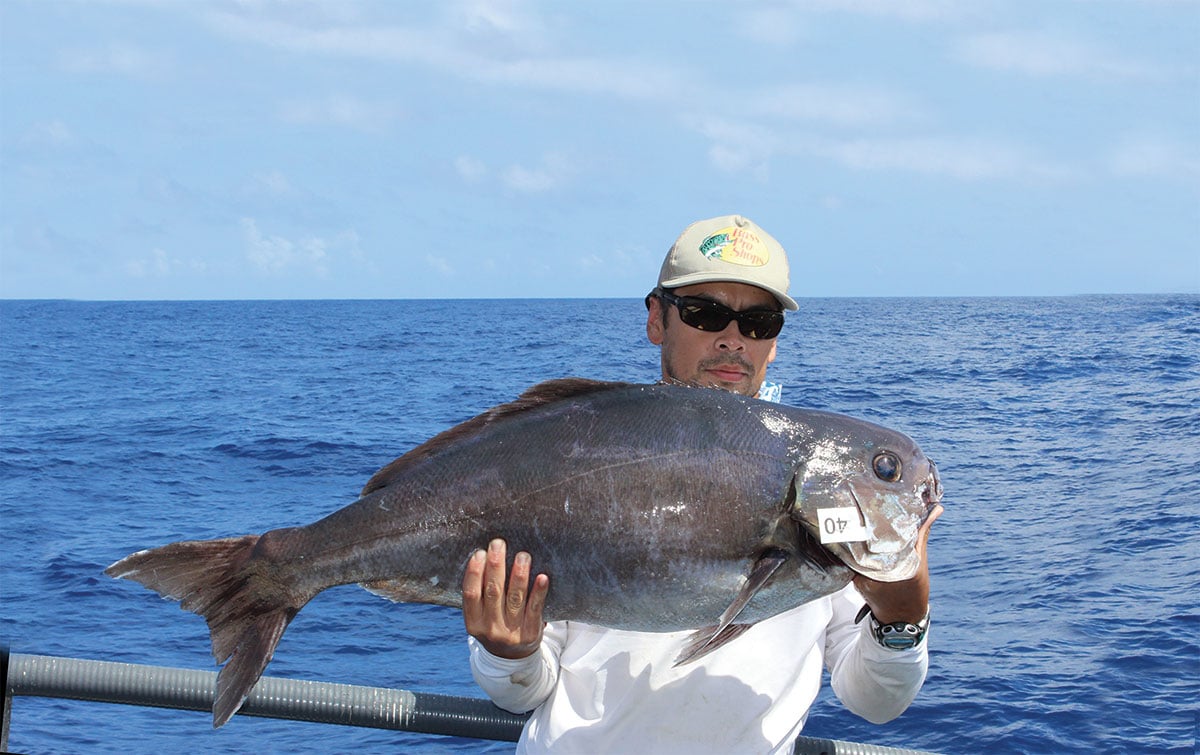A popular destination for snow birds and tarpon hunters, Key West also offers great rail action for bottom fishing fans.
Pulley Ridge starts about 110 miles west and slightly north of Key West, FL. It is about 186 miles long and 9 miles wide. According to scientists at NOAA, the southernmost 30 miles is a series of sunken barrier islands. It also has some of the best bottom fishing you will ever experience.

The 110-foot twin diesel aluminum party boat Yankee Capts from Stock Island in Key West runs open boat and charter trips to Pulley Ridge on a regular basis (weather permitting). Capt. Greg Mercurio and I have been close friends for the past 30 years and I have fished with him both out of Gloucester, MA and Key West, FL. Greg heard about Pulley Ridge from several Key West commercial fishermen and they made it sound like a bottom fishermen’s paradise – and they were right!
Greg made his first trip to Pulley Ridge in the early summer of 2013. During his first drift ever there he called me at work from his sat phone and could not contain his excitement as snowy groupers and yellow edge groupers were flying over the rail. At that point I knew I had to experience that for myself, making my first trip to Pulley Ridge in October of 2013.
Pulley Ridge is unique in that it offers both true deep drop fishing in depths from 400 to 1,200 feet as well as shallower fishing in depths ranging from 200 to 300 feet. Between the two areas it is possible to see in excess of 30 different species landed. Pulley Ridge is also home to many different types of corals and algae, both shallow water types and deep water types. Because of this abundance of life on the bottom, anchoring there is prohibited and all recreational fishing must be done by drifting. Therefore, weather and sea conditions are the key to success or failure on Pulley Ridge.
Deep Drop Diversity
The deep drop fishing is done during the day from about 9 a.m. until late afternoon. At that point, Greg will make the run from the deep to up on the bank for sunset through early morning. The trip starts with deep drop fishing, where I found that the same circle hook rigs I use for tilefishing on the Voyager back home in New Jersey just as effective in the deep on Pulley Ridge. It’s important to remember that in the Gulf of Mexico all bottom rigs must have circle hooks.

My rigs have 8/0 Mustad 39933NP-BN circle hooks snelled on 80-pound test mono with 5/0 three-way swivels. I add 4-1/2-inch glow squid skirts to my rigs for added visual attraction. While I do not add light sticks or swordfish lights to my rigs, I have seen other anglers use them. I can’t say they outfished the rigs without lights but I can say I saw more tangled rigs with lights than without.
There are a variety of baits that work well. The boat provides squid and I usually bring other baits such as bonito, salmon, silver eels from home, and anything else I can cut into strips. On my last trip this past September, squid was the most effective bait I used. I also found that using squid cut in half was more effective than whole squid. This goes against my belief that big bait equals big fish. On a trip I did back in September of 2015, my friend Tom Coad from Pompano Beach, FL caught a 70-pound warsaw grouper on a half squid on his first drop to the bottom. Even when I use strip baits I cut them into 3/4- by 5-inch strips.
Sinker weights vary with conditions. I have used as light as 28 ounces and as heavy as 4 pounds. Just note that if you are planning a Pulley Ridge trip bring your own sinkers as they are hard to find in those weights in the Keys.
What you catch depends on the depth. In 400 to 600 feet of water you will catch snowy grouper, yellow eye snapper, blueline tilefish, yellow edge grouper, scamp grouper, almaco jacks, and amberjacks. As you drift from 600 feet and deeper you will start to see queen snappers. For many, including myself queen snappers are one of the most highly prized species on Pulley Ridge. They are hard fighting fish that fight all the way to the surface, they are beautifully colored ranging from bright pink and silver to almost orange, and best of all, they are delicious.
Once you start reaching the 750-foot range you could start to see barrelfish and golden tilefish along with the queen snappers and snowy, yellow edge, warsaw, kitty mitchell, and mystic groupers. No matter what depth in the deep, there is always a good chance of hooking an almaco jack, amberjack, or blackfin tuna. While fighting my first ever queen snapper hooked in 750 feet of water I hooked a blackfin tuna about half way up. Until they both came to the surface I had no idea what happened as the fight changed dramatically.
Tactics & Techniques
I fish the deep drop Pulley Ridge spots the same way I tilefish at home, making sure my bait is hooked in the center so it does not spin before it drops to the bottom. Once it hits bottom I make sure there is no slack in the line and then start slowly moving my baits up and down by lifting them no more than a foot or two off the bottom. I found this lifting technique results in more hits than just “dead sticking” the baits on the bottom. This holds true for Pulley Ridge as well as for tilefishing in the Mid-Atlantic canyons. When there is little or no drift and no current, break out your jigs. Gold and silver hammer jigs, Viking style jigs, butterfly jigs, vertical jigs, slow pitch jigs, and bucktails all work. If you plan on using jigs in those depths, make sure you have jigs from 10 ounces up to 32 ounces.
After a full day of deep drop fishing Capt. Greg leaves the deep water in favor of shallower, 200- to 250-foot depths for sunset and night fishing. There you can expect to encounter mutton snapper, blackfin (often called hambone) snapper, black grouper, red grouper, scamp grouper, sand tilefish, almaco jacks, amberjacks, and blackfin tuna. I have also seen cubera snapper, dogtooth snapper, and goliath groupers (must be released) landed.
You can either jig or bait fish in these shallower depths. While both methods produce, I prefer to jig. If you would rather bait fish you will need 5/0 to 7/0 circle hooks, 50-pound leader, #1 size barrel swivels, an assortment of bank sinkers from 8 to 16 ounces, and some 6- or 8-mm beads. You will be essentially fishing a fish-finder rig; start by tying or snelling a circle hook to about 6 to 8 feet of 50-pound leader. Next, tie about a 12-inch length of leader to one end of a #1 barrel swivel and with a sinker loop in the other end; slide that swivel on to your line (from your reel) and then add one or two beads and tie another swivel to the end. Finally tie your hook leader to the other end of the barrel swivel and you now have a Pulley Ridge fish-finder rig. I find this type of rig to be more effective than either a traditional egg sinker sliding rig or hi low rig.
Keep in mind you will be drifting in at least 200 feet of water so baits need to be carefully hooked to prevent them from spinning. Small, fluke-size squid and strip baits are both very effective and the easiest to hook. Once your rig hits the bottom, reel in about a foot or two off the bottom. The bottom is covered with scattered rocks, corals, and vegetation, so keeping your sinker slightly off the bottom will help prevent snagging the bottom while the long hook leader will still keep your bait close to the bottom. Also, many of the fish, especially mutton snapper, tend to be skittish and the banging of sinkers along the bottom can be enough to scare them off.
Bag Check Your Gear
When I first started to fish Pulley Ridge, no one really jigged for the bottom fish. The only anglers that jigged did so at night for blackfin tuna. Now, anglers jig both day and night. I started to jig the bottom with 12- and 14-ounce OMT bucktails tipped with Gulp! 6-inch grubs after I saw my friend John Vafiadis land a 60-pound black grouper on an OMT 12-ounce bucktail and Gulp! grub combo. Three drops in a row produced three red grouper all over 20 pounds. Since then I have had success with butterfly jigs, hammered diamond jigs, hammered Viking style jigs, and most recently slow pitch jigs. For bottom jigging take an assortment of jigs from 8 to 14 ounces; for slow pitch jigging bring jigs from 100 to 250 grams, and for blackfin tuna jigs from 3 to 6 ounces.
A final key to success on Pulley Ridge is having the correct rods, reels, and line. I use my tilefish outfit for the deep drop fishing. My rod is a Cousins Tackle 8-foot tilefish rod (which I designed for them) paired with either an Ocean Max 10 (4.5:1) reel or Accurate Extreme Boss 600N (4:1) reel. Both reels are spooled with 50-pound braid and a 35-foot top shot of 60-pound Momoi Hi Catch mono. For the shallower bottom fishing I use a Phenix PHD 809XH rod paired with either an Accurate Extreme Boss 500 (4:1) or an Ocean Max 5 (4.5:1). They are also spooled with 50-pound braid with 60-pound top shots. This combo can be used for both jigging and bait fishing.
For the blackfin tuna I use a Shimano Terez 72M spinning rod with a Shimano Stella 8000 spooled with 40-pound braid and a 6-foot top shot of 40-pound Momoi Hi Catch mono. For slow pitch jigging I use two different rods, a Shimano Game Type J rod and a Temple Reef Levitate rod. For reels I use an Accurate Boss Valiant 300 and a Shimano Trinidad 16A, each spooled with 40-pound Power Pro Max Quattro braid and a 10-foot top shot of 40-pound Momoi Hi Catch.
Pulley Ridge is a special place. If bottom fishing combined with a little tuna fishing is in your blood you need to experience it for yourself. I try to make two trips a year when possible (Yeah sometimes work gets in the way.) and I usually drive so that I can take all of my gear; more importantly so that I can drive home with a cooler full of delicious fillets.




